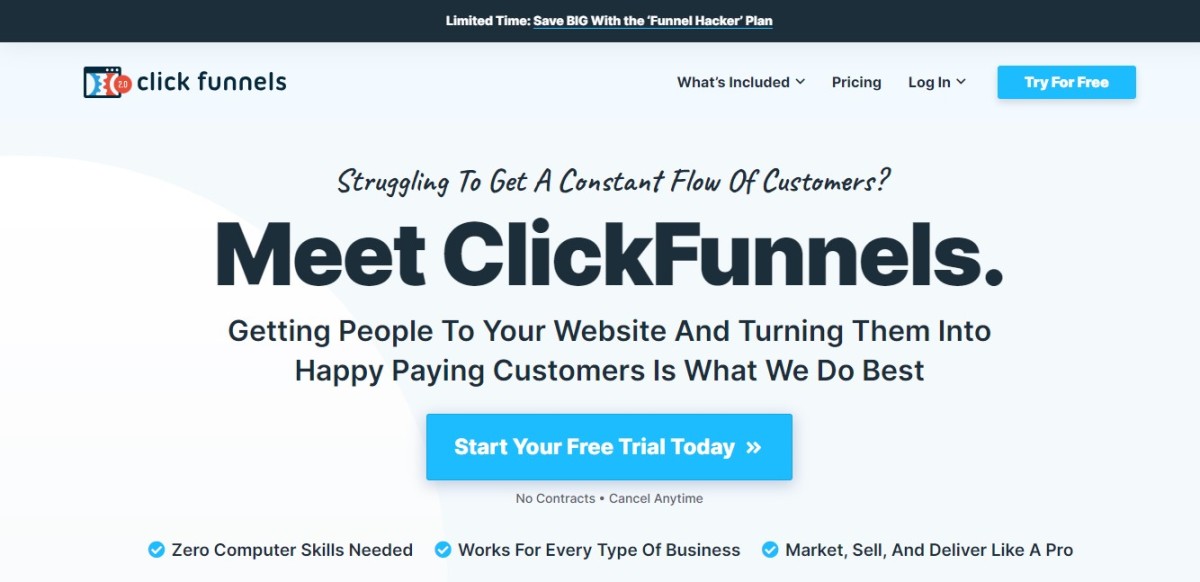There are so many tools and apps out there to help businesses with their sales process that it can be hard to keep track of them.
One such app is ClickFunnels, which describes itself as a service for people who are “struggling to get a constant flow of customers”.
ClickFunnels’ website is full of excited marketing speak and user testimonials, but amongst the buzz, it can be hard to figure out exactly what ClickFunnels actually does and why it might be useful for your website.
Here’s a rundown of what ClickFunnels is, its step-by-step process, and whether or not you should consider implementing it for your business.
ClickFunnels in a nutshell
While the term “sales funnel” might sound like an actual element of a website or business, the fact is that it’s essentially a marketing buzzword.
The funnel is a way to refer to the customer journey on an ecommerce site, say; it’s the whole process customers go through when they’re buying a product, from seeing your marketing all the way through to actually making a purchasing decision.
That’s where ClickFunnels comes in.
The service itself describes the funnel as “kinda like a bridge” that attracts customers from social media, search engines, and other places, directing them into your online store.
ClickFunnels offers various different kinds of sales funnels, including lead funnels, conversion funnels, and webinar funnels.
Whatever you want customers to do, ClickFunnels promises to help you. The service says each funnel is “like a new road that leads back to your website and your store”.
Funnels on ClickFunnels are basically pre-built “story” templates
A quick browse of ClickFunnels’ template marketplace shows a number of different funnels that you could potentially incorporate into your own website.
This shows that sales funnels are effectively pre-worked website designs that are supposedly effective at attracting and retaining customers for different customer journeys.
There are lots of different types of template available on ClickFunnels’ website, and they’re all geared towards a different type of funnel.
ClickFunnels says that its sales funnels are used by over 100,000 “active businesses” each day, and that 1% of ClickFunnels users manage to generate at least $1,000,000 using a funnel.
It’s not just funnels
ClickFunnels doesn’t just offer funnels, whatever the name may imply.
The service is also a one-stop shop for many other aspects of the customer journey, including a website builder, a blog tool, and automated marketing workflows.
Other features currently in the works for ClickFunnels (at time of writing) include an ecommerce store builder, a shopping cart tool, and a CRM (Customer Relationship Management) system, so it looks like ClickFunnels is hoping to compete with Shopify.
Why should you use ClickFunnels?
Many businesses will often use multiple tools across the customer journey, with each tool controlling or monitoring a different element.
Naturally, this can feel like an inefficient approach, and that’s where ClickFunnels shines.
It promises to collect all of the different aspects of the customer journey under one umbrella, allowing you to control the entire process without needing multiple disparate pieces of software.
You can create funnels, make a great-looking website, and set up a blog all from the same tool, which should give your website a unified feel and stop it from feeling unfinished or unfocused.
As for why you should use sales funnels, they’re generally regarded as an important part of the customer journey.
Generating sales and leads online can be significantly more difficult for businesses than it is in person.
After all, when you’re in conversation with someone about buying something, you can hold their gaze and use body language to more effectively communicate the benefits of a sale.
However, when a customer is online, they hold significantly more sway over their purchasing decision; they can simply choose to leave the website whenever they like, and the sale can fall through at any moment.
Sales funnels, like those offered by ClickFunnels, promise to increase the chances that a sale will continue through to a purchase, since they’re specifically designed to lead customers down a specific path.
What are the pros and cons of ClickFunnels?
There are benefits and drawbacks to using ClickFunnels, or, indeed, any lead-generating service. Here are some of those pros and cons.
Pros
- Makes the sales process easy. Creating and maintaining sales funnels and sales pages can be very difficult, and ClickFunnels makes this process relatively straightforward.
- Advanced analytics. Once you’ve put your page in place, ClickFunnels can help you track whether it’s working and redirect your efforts towards generating better sales or leads.
- Free trial. You don’t need to pay for ClickFunnels immediately; you can try the service out to see if you like it before you make a commitment.
Cons
- Expensive. ClickFunnels is far from the cheapest service of its kind out there, and if you look around, you can easily find something that’ll cost less.
- Not very customisable. While ClickFunnels does have some customisation options for its templates, it’s less powerful than some of its competitors.
- Might look generic. Using templates is a good idea if you don’t have a lot of experience creating funnels, but it might also mean that your site looks like everyone else’s sites.
Are there any alternatives to ClickFunnels?
Naturally, ClickFunnels isn’t the only service out there offering pre-built sales funnels for your website.
Other services include Instapage, which is significantly more expensive but perhaps slightly more sophisticated, and Leadpages, which is great for businesses or individuals on a stricter budget.
The fact is that if you don’t like ClickFunnels for whatever reason and you shop around, you’ll find plenty of alternatives, but that should just go to show how important it is to incorporate sales funnels for your site.


